Understanding the lighting requirements for bearded dragons (and most reptiles in general) can be confusing for beginners – which is completely understandable.
There are tons of different options and picking out the wrong fixture can actually be harmful to your bearded dragon’s health.
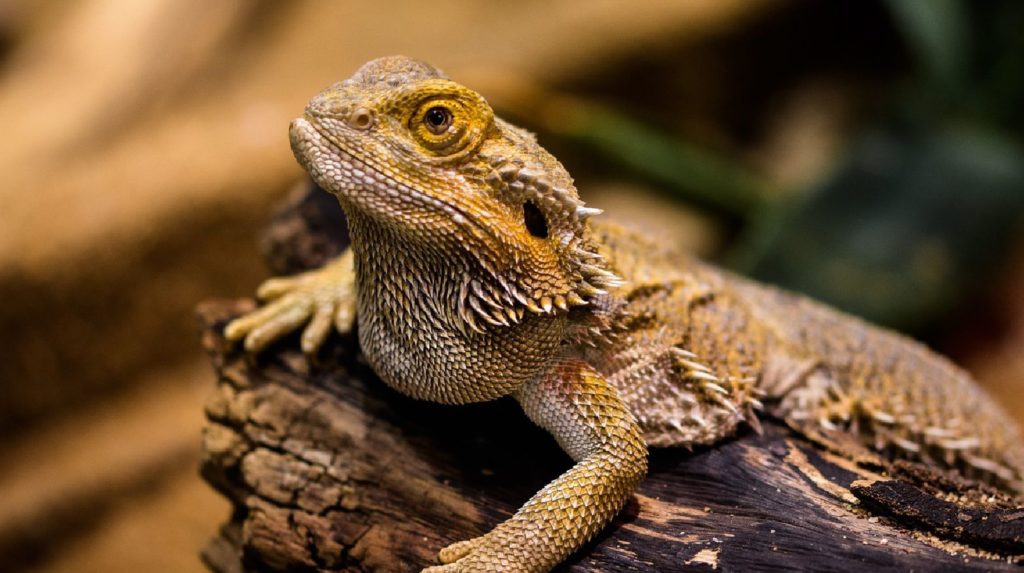
Dont worry, though! This article will teach you everything you need to know about Bearded Dragon lighting. Here are a few things we will cover:
- The EXACT types of bulbs that you need (and why they’re important)
- Where you should place each light
- Achieving an ideal temperature in your tank
- Frequently asked questions about bearded dragon lighting
Quick Navigation
Bulb Placement
Bulb placement is a little more complicated than simply mounting the light fixture anywhere on the top of your tank. As a result, improper bulb placement is one of the most common mistakes made by first-time bearded dragon owners.
Here is an simple infographic that shows you how to set up your bulbs the correct way.
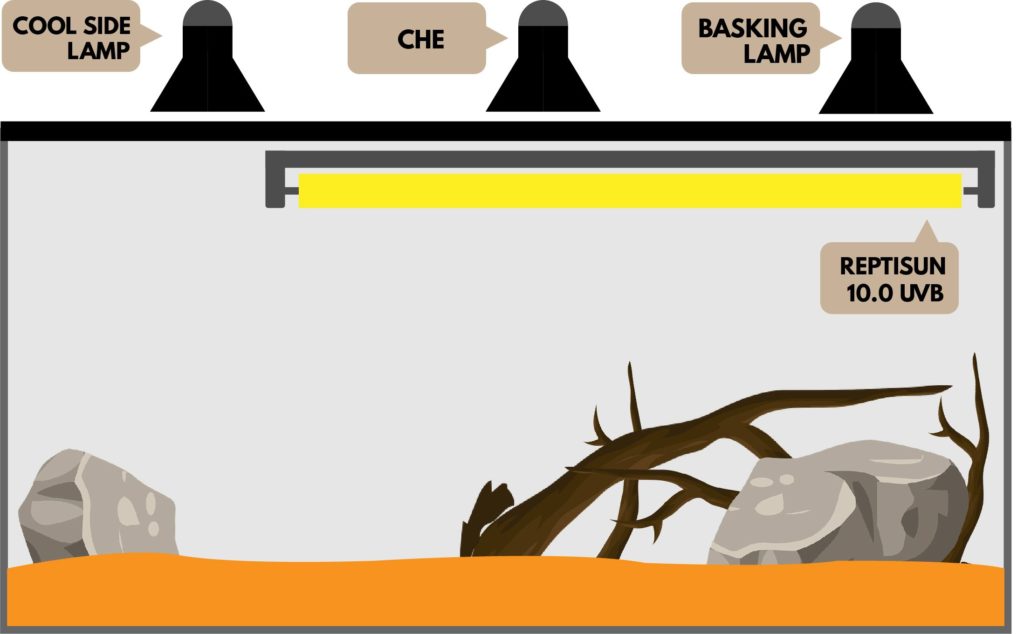
Over the course of this article, we are going to cover exactly what each of these lights are used for and how you should organize your bearded dragon’s tank in regards to lighting.
UVB Lighting
UBV fluorescent lighting is the backbone on any bearded dragon setup – without it, bearded dragons develop something called Metabolic Bone Disease (along with a few other health problems). Here are a few things you should know about UVB lighting:
What is UVB light and why is it important?
UVB (or untraviolet-B) light is electromagnetic radiation that falls between 280 – 315 nm. For humans, this might not mean too much – after all, our eyes aren’t adapted to see this spectrum of light.
For bearded dragons and many other reptiles, though, UVB light is the key to survival.
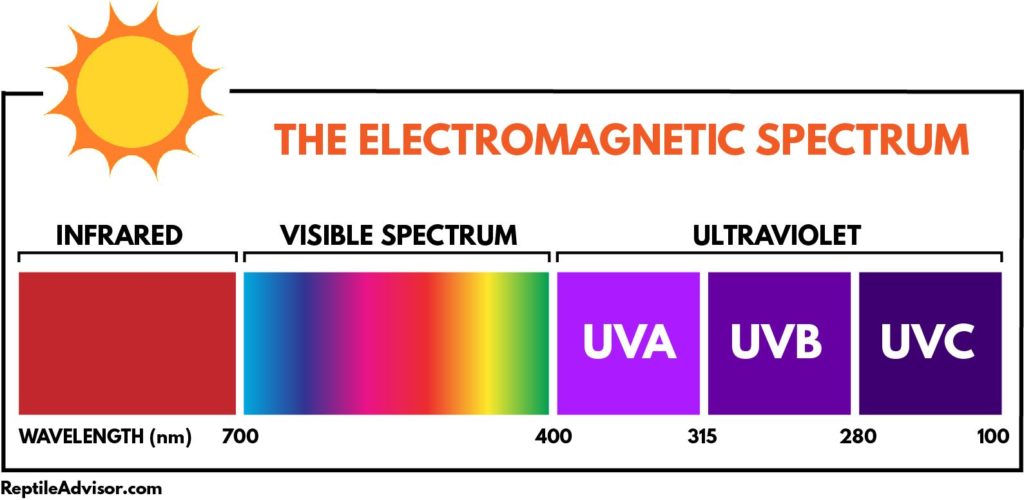
So we know that UVB light is necessary for reptiles – and that a lack of UVB light can lead to a range on health conditions – but why?
In reptiles, UVB light helps regulate the production of Vitamin D3 within the skin. Vitamin D3 is extremely important because it allows your bearded dragon to absorb and use calcium. As a result, reptiles without proper UVB light will have low Vitamin D3 levels, and therefore low calcium levels.
As we discussed above, bearded dragons with low calcium levels often suffer from something called Metabolic Bone Disease (juveniles are especially susceptible).
This is a very painful disease that causes bone issues and deformities, so make sure you provide proper lighting from the start.
UVB Lighting Placement and Sizing
Choosing the right size UVB light is very important in keeping your bearded dragon healthy. Ideally, the UVB bulb should span 2/3 to 3/4 the length of your tank. This allows your bearded dragon to absorb beneficial UVB rays no matter where is chooses to rest/sit.
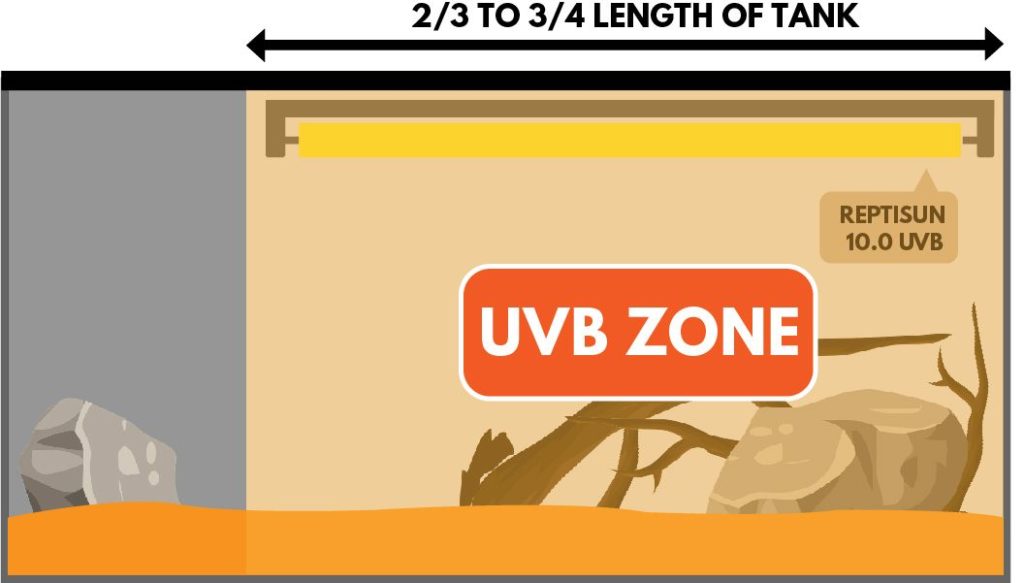
When placing your UVB light, mount it all the way to one side of your tank (preferably the side with the basking light).
Giving your beardie a small portion of the tank (1/3 to 1/4) with no lighting helps create a “cool zone”, which can be necessary for body temperature control.
What is the best UVB light for Bearded Dragons?
When it comes to picking out a UVB fluorescent bulb, there is one clear winner that dominates the pack – the Zoo Med ReptiSun 10.0 UVB Lamp is definitely the way to go. Zoo Med is a great company and their UVB bulbs have a solid reputation among reptile enthusiasts.
But wait…just when you thought our pick was simple, there are a few more things that we have to cover.
First of all, the Zoo Med ReptiSun is available in two versions: T5 and T8.
In my opinion, the T5 is vastly superior – it has a much higher UVB output and can be placed 12″ to 18″ away from your bearded dragon.
In addition, T5 fixtures can sometimes be mounted above the mesh top of your enclosure. If you plan to do this, though, use a reflector to maximize UVB output (since mash screens can filter out 30-50% of UVB rays).
T8 bulbs, on the other hand, should be placed within 8″ of your Bearded Dragon. Since UVB output is much lower in T8 fixtures, the bulb must be placed inside of the tank.
- The best fluorescent tube that weve ever used for our reptiles UVB requirements! Other tubes that we...
- A UVB 10.0 Reptile Fluorescent Tube means that 10% of the tubes output is UVB. This UVB is necessary...
- Some reptiles require more or less UVB than others. Bearded dragons and similar desert reptiles...
What fixture should I use?
As we just learned, picking out the right UVB bulb for your Bearded Dragon is a pretty specific process. Choosing a fixture to house your UVB bulb is on the completely different end of the spectrum – you have a lot of flexibility (any T5 fixture of suitable size should do).
If you’re looking for a really nice fixture, I recommend the SubBlaster NanoTech T5HO Reflector Combo. It’s a little more expensive than the fixtures you might find at a hardware store, but it’s fitted with a nice reflector that will really increase your UVB output.
Mounting the UVB fixture inside of your tank is actually pretty simple – just pick up a few command hooks and attach them to the back of your tank. It may seem funny that the fixture is mounted towards the back side of your tank, but this is completely normal.
How often should I replace UVB bulbs?
As UVB bulbs age, their output falls out of the 280-315 nm range. As a result, it is extremely important that you replace your UVB bulbs regularly – every six to twelve months is a good rule (T8 fixtures burn out quicker, usually around 6 months. T5 bulbs can last up to a year).
Remember – humans can’t see UVB light. So although a 2 year old bulb looks perfectly fine to the naked eye, it is most likely completely ineffective for Vitamin D3 synthesis in bearded dragons.
The Basking Light
The basking light is a very important part of any reptile enclosure. By mimicking natural heat produced by the sun, basking lights give reptiles a way to absorb warmth and regulate their body temperature.
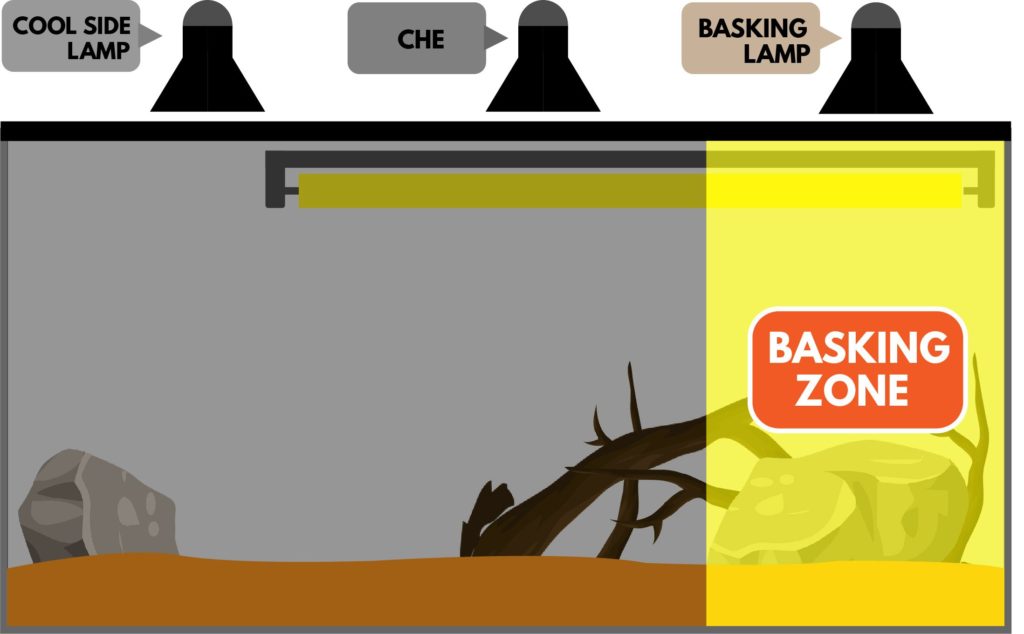
There are tons of basking light options on the market made specifically for retiles.
In my experience, a simple flood light with a halogen bulb paired with a Flukers Clamp Lamp works perfect and is much more affordable. The most important thing when it comes to basking light is making sure it delivers enough heat. I recommend picking up a cheap digital laser thermometer to keep track of temperatures.
Baby bearded dragons prefer slightly warmer temperatures, somewhere between 105-110°F. Mature Bearded like it a few degrees cooler, usually between 100-105°F.
When it comes to wattage and placement, you really just have to feel it out. Personally, I’ve found that a 90 to 100 watt bulb at 20” gives me a basking temperature around 105-110°F.
Depending on insulation and bulb type, though, every tank will be different. Move your light up and down to increase/decrease the basking surface temperature.
The “Cool Side”
As you can see from our illustration, a proper bearded dragon setup should have some sort of “cool side”. Giving your bearded dragon a place to escape the heat of the basking lamp helps them cool off and regulate body temperature.

While the basking zone usually sits around 100-110°F, the cool zone should hover around 80-90°F.
Achieving a proper temperature gradient is important in any Bearded Dragon enclosure – this is why we place the basking and the cool zone lamp on opposite sides of the tank. If the zone directly under the basking lamp is too hot, your bearded dragon can gradually move towards to cool zone until it finds the perfect temperature.
So…is a light really required on the cool side of your tank? Not at all. In fact, a lot of bearded dragon owners don’t use any light at all on the cool side. That said, it can be helpful if your room is dark (since beardies tend to like visual light). In addition to increased activity, a bit of visual light on the cool side can also help encourage a strong appetite in your bearded dragon.
A simple household bulb should be fine for the cool side lamp – just make sure it doesn’t bump the temperature up too high. If it does, try switching to an LED bulb as they put off much less heat.
Ceramic Heat Emitters
Ceramic Heat Emitters are exactly as they sound – ceramic fixtures that use invisible infrared light to heat up your bearded dragon’s enclosure.

It is important to note that Ceramic Heat Emitters are NOT always necessary. As long as the temperature in your tank doesn’t drop below 70°F at night, a CHE isn’t really required.
If the temperature in your tank drops into the mid to low 60’s at night, you should probably consider investing in a CHE – they are pretty inexpensive and will help bring the nigh time temperature into the perfect 70’s range. The Ceramic Reptile Heat Emitter is our recommended option.
Ceramic Heat Emitters don’t require any specific placement like we saw with lighting.
Some people light to place their CHE to one side of their tank (as to get a good temperature gradient), while others like to place it near the middle – just try to figure out what works best in your setup.
Creating a Temperature Gradient
Notice how a few of our “zones” overlap? That is what we call a temperature gradient.
Basically, creating a temperature gradient allows your bearded dragon to choose a comfortable temperature by adjusting its position in the tank.
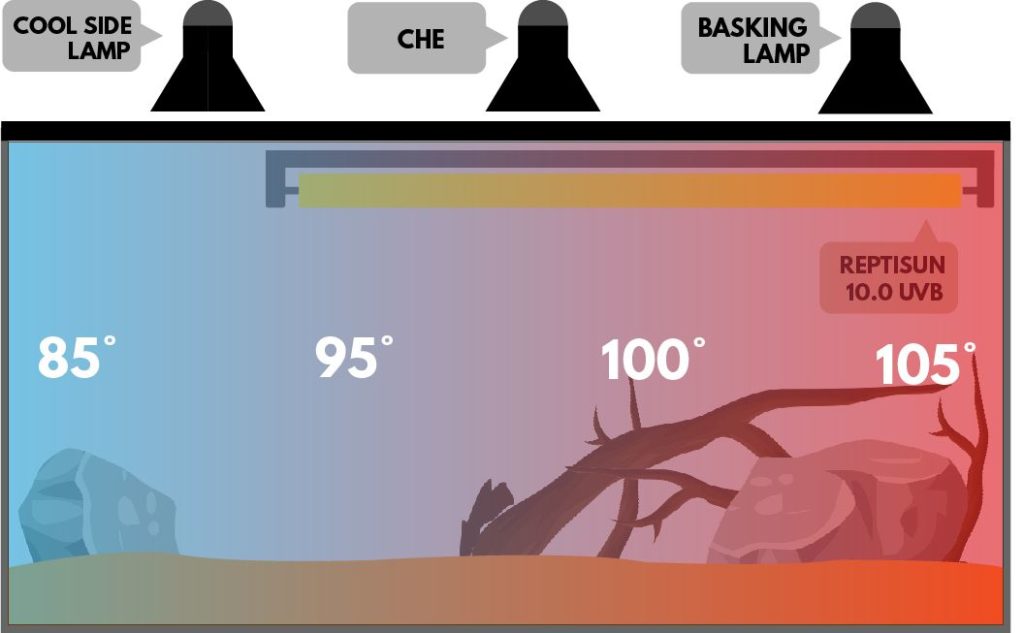
So what do you do if you purchase all of your lights and set them up, only to find that your temperature is all out of whack?
The most common way to fine tune the temperature in your tank is by adjusting the height of your lights. If the tank is too hot, move you lights up (with a clip or something similar).
A setup that runs too cold is a little trickier. In this case, you’ll probably have to increase the wattage of your basking light. As we stated before, though, any halogen bulb should work (so it shouldn’t be expensive at all).
Lighting at Night – Yes or No?
Just as humans don’t appreciate bright lights during sleep, either do bearded dragons! In fact, they sleep best with no light at all.
Unfortunately, there’s a lot of misinformation regarding this subject. There are tons of red and blue “night lights” on the market that look nice, but will actually upset your Bearded Dragons sleep cycle.
Truthfully, it seems as though these were made simple as another product to sell to new bearded dragon owners…
Simply put – you’re Bearded Dragon’s tank shouldn’t have any lights running at night.
Another reason that people tend to run lights at night is to keep the temperate up. If you tank temperature falls into the 60’s at night, invest in a Ceramic Heat Emitter instead of running the lights 24/7.
CHEs produce heat without the use of visible light, so they’re perfect for heating your tank without upsetting your dragon’s sleep cycle.
Frequently Asked Questions
Here are a few of the most commonly asked questions about bearded dragon lighting:
UVA vs. UVB – What’s the difference?
We could go into the technical details about the different types of UV light – but you probably don’t care about that. What you really need to know is that UVA light is emitted from just about every type of light bulb, while UVB light is not. While UVA light is helpful for stimulating appetite in your bearded dragon, it doesn’t help with the production of calcium. As a result, UVA isn’t a proper substitute for UVB light in a reptile setup.
Should I mount my UVB light inside or outside the tank?
Ideally, the UVB tube bulb should be mounted inside of your tank. The reason for this is that glass/mesh tops filter out a large amount of UVB rays (usually between 30-50%). The exception to this rule if you’re using a T5 bulb (which I recommend) with a reflector. If you’re using a T8 bulb, your light fixture definitely needs to be mounted inside of the tank.
How do I hang the fixture inside of my tank?
When I was setting up my first bearded dragon habitat, I was very confused at the idea of mounting a fixture inside of my tank. In reality, it’s actually very simple – just purchase a few 3M command hooks, stick them to the inside of your tank (on the back wall), and mount it from those.
How many hours should I run my lights?
I recommend running your lights 12-14 hours a day. Bearded dragons can be sensitive to lighting schedule changes, so I recommend picking up a timer to automate everything.
Do I need to heat my tank at night?
If the temperature in your house doesn’t fall below 70°F, you probably don’t need to worry about heating your tank at night. Once temperatures start to fall into the 60’s, though, you should consider picking up a ceramic heat emitter (otherwise your bearded dragon may go into brumation). CHEs heat your tank without the use of visible light (as to not mess with your bearded dragon’s sleep schedule).
What is the ideal temperature?
The ideal temperature for you breaded dragon largely depends on its age. Baby bearded dragons are most comfortable when the basking zone ranges from 105-110°F. Adults, on the other hand, prefer it slightly cooler at 100-105°F. When it comes to the cool zone, anywhere from 80-90°F should work (regardless of age).
Quick Summary
If you don’t have time to read our entire article, here is a quick summary of what you need to know:
- A UVB tube light is an absolute must – we recommend the ReptiSun T5 10.0 UVB. Mount it inside of your setup with 3M command hooks.
- A basking light is equally important – a halogen bulb should work fine (don’t waste your money of “reptile bulbs”). Mount it all the way to one side of your setup.
- If the temperature in your house drops into the 60’s at night, invest in a ceramic heater. Only run it at night.
- A cool side lamp isn’t required, but can make your tank more visually appealing.
Last update on 2024-07-26 / Affiliate links / Images from Amazon Product Advertising API

OMG thank you. I have been so confused about what goes where. This spells it out. I really appreciate your diagram and that you said not to worry if you don’t understand what each bulb is because we will get there.
Thank you for the helpful information. Do you recommend sand or liner in the terrarium?
Hi Christie, we generally do not recommend sand as it can cause impaction in bearded dragons. I actually have a whole guide on bearded dragon substrates. You can see it here: https://www.reptileadvisor.com/bearded-dragon-substrate/